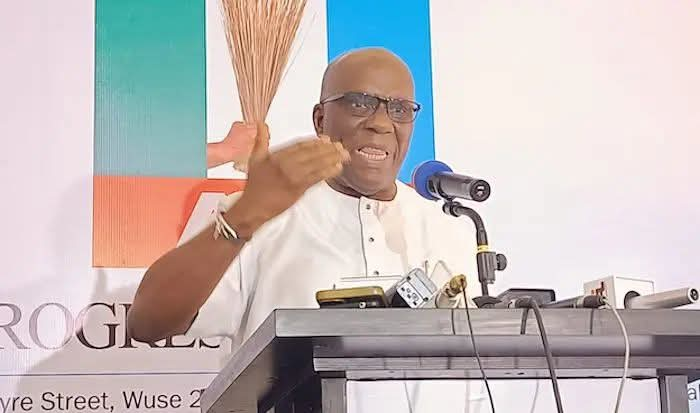News
Buhari Govt Launches Better Health For All Program (Bh4a)

ADDRESS OF THE HONOURABLE MINISTER OF HEALTH, PROFESSOR ISAAC F. ADEWOLE FAS,FSPSP,DSC(Hons) AT THE PRESS BRIEFING TO LAUNCH THE RAPID RESULTS INITIATIVE ON MONDAY 18TH JULY, 2016
PROTOCOL
I am highly delighted to address you today, on the occasion of the launch of the BETTER HEALTH FOR ALL PROGRAM (BH4A) of the Federal Ministry of Health. The program is a Rapid Results Initiative (RRI) borne out of the need to respond to the critical needs of the people and deliver on the mandate of promoting health with focus on Access, Affordability and Demand.
The program encapsulates a set of initiatives borne out of the vision of the administration of His Excellency President Muhammadu Buhari GCFR to produce quick and visible impacts that will altogether affect the lives of every Nigerian especially the most vulnerable and the poor in our society. The goals documented under every result area under the program will challenge our collective and corporate abilities, foster sectoral and inter-sectoral collaboration to deliver critical interventions to the people of Nigeria. They are really ambitious goals but certainly ‘doable’ goals meant to keep us all on our toes for the next 100days of implementation.
The Better Health 4 All program is our RRI, a concept jointly designed and promoted with the Rapid Results Institute in the United States of America. The RRI model was initially adopted by the social sector and corporate organizations to drive developmental agenda. Further down the line, RRI has been adapted for quick impact in the health sector.
The concept is currently being used in the United Kingdom to support the National Health Service (NHS) to expand integrated social and health care to the elderly. It has also been used to support the government of Rwanda, Sierra Leone, Ghana and Kenya in the sub Saharan Africa. It is meant to achieve clearly defined goals within a specified period of time.
Our Rapid Results Initiative, the BH4A, would be deployed in seven major areas that are thought to conform to both local and international health priorities. They are areas that were thought to have significant and visible impact on the lives of our people especially, the poor and most vulnerable in our society. Our well-motivated teams are ready to commence work in the following areas;
I. Revitalization of PHCs
Under this project, we will work to revamp 110 Primary Health Centres (PHCs)within the next 100 days; one in each senatorial district including a facility in Fuka Local Government in Niger State. FUKA community that recently suffered high case fatality (17 people died) from Lassa Fever due to cultural interpretation of the cause of the disease. During my unscheduled to FUKA, I noticed that there was no functional PHC to offer basic health care and I promised that Federal Government will provide a functional facility. Today as we speak, FUKA PHC is ready for commissioning.
May I also inform this gathering that mapping of these PHC facilities have been carried out by the National Primary Health Care Development Agency (NPHCDA). The agency has also assessed the levels of human resources; infrastructure; basic PHC service delivery package; commodities, and equipment as stipulated for a standard PHC in Nigeria. We shall identify those facilities within the senatorial districts for manpower development, conduct reorientation and train staff to man these facilities. In addition, Ward Development Committees (WDCs) shall be activated within 110 communities where the PHCs are domiciled to ensure excellent governance, accountability, and community mobilization.
We will also embark on the upgrade of infrastructure in 110 facilities in line with the minimum standards for PHCs in Nigeria. Functional supply and logistics system for essential PHC drugs and commodities through Drug Revolving Funds (DRF) would be set up in the 110 facilities. Other cadres of health workforce have been identified and will be appropriately deployed to these facilities.
The ultimate goal of the PHC – RRI is to ensure that 110 PHC Centres (one in each senatorial district plus the Fuka PHC in Niger State are made functional to deliver quality PHC services that will lead to increased antenatal care coverage and skilled birth attendance as well as increase in immunization coverage for 3 childhood killer diseases. The functionality of these PHC facilities will be defined by the Minimum Standards for PHC in Nigeria.
II. Mutual Health Assurance
Mutual Health Assurance is another RRI goal that is closely related to the uptake of the services within the PHCs. Our commitment as an administration is to set Nigeria on the course to achieving Universal Health Coverage (UHC). Within the RRI timeline, we will inaugurate Mutual Health Associations (MHAs) at community levels to improve access to affordable and qualitative health care.
Mutual Health Associations (MHAs) are privately or publicly incorporated body registered by the National Health Insurance Scheme solely to access health care services through health care facilities accredited by the scheme. They are not for profit organization but formed on the basis of solidarity and collective pooling of health risk by community members. These MHAs shall be governed by their constitutions and bye laws. Membership of this organisation will be drawn from the community and will be responsible for the daily management.
The RRI goal of MHA is to establish at least 30 operational MHAs by October 2016 with capacity to disburse funds to health facilities in their domain.
III. Treatment of 200,000 Severely Acutely Malnourished children.
As we all know, malnutrition has a devastating health effect in children especially on their physical and intellectual growth. The negative effect of malnutrition is maximal in the first few years of life and this coincide with period of rapid growth and development in children when high calories and nutrients are required.
Malnutrition is associated with extreme weight loss, stunted growth, poor resistance to infection and in extreme cases, it could result in death. Malnutrition has also been shown to impair cognitive function in children.Acute malnutrition is a life threatening situation and silent emergency killer in under-5 children.
Malnutrition among Nigeria’s children is a serious problem throughout the country: Each year about 1 million Nigerian children die before their 5th birthday. Malnutrition contributes to nearly HALF of these deaths. The rates of stunting in Nigeria have stagnated for more than a decade. About 2 in 5 Nigerian children are stunted, with rates of stunting varying throughout the country. Almost 30 percent of Nigerian children are underweight, meaning they don’t weigh enough for their age. This is more than double the proportion of neighbouring Ghanaian children who are underweight. The percent of children in Nigeria who are wasted, or too thin for their height, has steadily increased over the last decade, rising from 11 percent in 2003 to 18 percent in 2013. The burden of malnutrition varies by the geo-political regions. The details are summarised in the table:
NUTRITIONAL INDICES BY ZONES – (2013 NDHS) ACCORDING TO SIX GEO-POLITICAL ZONES
ZONES
Stunting (%) Wasting (%) Underweight (%)
North Central 29.3 11.7 18.5
North East 42.3 19.5 30.8
North West 54.8 27.1 47.4
South East 16.0 11.9 11.4
South-South 18.3 11.1 12.8
South West 22.2 10.0 14.9
Based on the above indices, there is an urgent need to intervene with an emergency feeding programme while we work on long term solution.
The RRI project will focus on treating 200,000 Severe Acutely Malnourished (SAM) children who are under-5 in Northeastern region of the country. We will be concentrating our effort in Borno and Yobe states – the two most affected states. We shall implement the therapeutic feeding programme (as articulated in the National Strategic Plan of Action for Nutrition) for the under-5 children with SAM.
In view of the critical situation in Borno State, we have declared Nutrition Emergency. Consequently, the FMoH have deployed a RRI team to the affected area in Borno state. The team will assess and evaluate children with acute malnutrition; working with the Borno State Government and Development partners, we will offer care to 200,000 children with acute malnutrition.
The ultimate goal of this RRI project on nutrition is to promote and ensure implementation of Infant and Young Child Feeding (IYCF) services in all facilities using locally produced Ready to Use Therapeutic Foods (RUTF).
IV. Surgical intervention component
Under this intervention, 10,000 surgeries, including herniorrhaphy, cleft lip, and palate repairs, myomectomy, hysterectomy, Vescico-Vagina Fistula (VVF) amongst others would be carried out in 46 tertiary institutions for indigent Nigerians. We have set criteria to screen for eligible people that will benefit from the project.
The NHIS platform would be used to carry out these surgeries using the social rates. We therefore encourage interested Nigerians to register free of charge with NHIS at closest centres to them.
V. Operationalizing the Nigeria Centre for Disease Control
Our goal in this initiative is to have a least one laboratory in each geopolitical region including the Federal Capital Territory have linkages and referral networks, and are able to collect, process and ship surveillance specimen for testing in laboratories in Nigeria. This goal is particularly important in building a resilient health care system that is able to withstand the devastating effects of disease outbreaks in a multi-cultural setting like ours.These tertiary hospitals are listed as follows:
i. University of Port Harcourt Teaching Hospital (South South)
ii. Aminu Kano Teaching Hospital, Kano (North West)
iii. University of Maiduguri, Borno State( North East)
iv. University of Enugu Teaching Hospital (South East)
v. Lagos University Teaching Hospital (South West)
vi. Jos University Teaching Hospital (North Central)
vii. Asokoro/ Gwagwalada Specialist Hospital, FCT
VI. Screening of Nigerians for Major Diseases
Nigeria like any other country in Africa and around the world has its fair share of Non Communicable Diseases notably Diabetes Mellitus (DM). Globally, it was projected that the number of people (age 20yrs-79yrs) with DM worldwide will increase from 382million in 2013 to 592million in 2035, in sub Saharan Africa and people living with DM will increase from 19.8million in 2013 to 41.4million in 2035. This is largely due to growing urbanization in the world. However, some of these NCDs are preventable by lifestyle modifications if the risk factors are detected early.
Over the past 30years the prevalence of DM has increased steadily. In 1971, a hospital survey by Osuntokun et al in Ibadan estimated a prevalence of 0.4%; In 1989, while screening for Diabetes during a World Diabetes Day(November 14) in Lagos metropolis, Ohwovoriole et al found a prevalence of undiscovered Diabetes of 1.6%; A national survey in 1992 by the Non-communicable Disease Expert Committee of the FMOH recorded a prevalence of 2.2% (National)- Lowest 0.5% in Mangu, Plateau State and highest 7% in Lagos Island.
The prevalence of DM in Nigeria has increased from 2.2% as reported by Akinkugbe in 1997 from a national survey to 5.0% by 2013 according to estimates of the International Diabetes Federation (IDF). Complications of diabetes are common at the time of presentation in Nigeria: neuropathy 56%, erectile dysfunction 36%, nephropathy 9%, and retinopathy 7%.
The Non Communicable Disease division of FMoH will partner with a multinational pharmaceutical company Novo Nordisk to screen about 500,000 Nigerians for diabetes and they would be appropriately referred to facilities that would cater to their needs if that is warranted.
We shall also measure the blood pressure of every consenting Nigerian to screen for high blood pressure which is another silent killer.
Hepatitis remains a public health concern in the world. It has been shown that about 300 million people worldwide are estimated to be infected with Hepatitis B virus (HBV). Nigeria is one of the countries with the highest incidence, with a prevalence of 10-15%. Across the country, the male to female predilection varies and children are not spared. Medical personnel, especially surgeons and dentists are at the greatest risk of infection, while other health workers, commercial sex workers, and drivers have also been found to be at significant risk of getting infected.
In Nigeria, there is a strong relationship between HBV infection and various forms of Chronic liver disease [CLD], including chronic hepatitis, liver cirrhosis and hepatocellular carcinoma. Hepatitis C Virus is not strongly implicated in the pathogenesis of CLD in Nigeria but coexistent HBV in Nigerian patient.
Consequently, the FMOH in collaboration with Roche Nigeria will be screening 40,000 Nigerians for hepatitis infection. We believe this initiative will provide opportunity for beneficiaries to know their sero-status and determine the state of their health.
VII. Transparency and accountability
The Media and Publicity component of the RRI will be on ground to engender trust and accountability through media campaigns, creating demands for the utilization of services so provided while monitoring the supply side to ensure that quality services are provided to the people as promised.
Likewise, monitoring and evaluation division of FMoH will develop a set of indicators to monitor the progress and impact of the project. Already, a few monitoring tools have been developed for this purpose to ensure that we track the progress we are making towards our stated goals.
In conclusion, I will like to encourage everyone to join us as we implement these seven ambitious goals within the next 100 exciting days of interesting challenge. Our successes in these goals will be used in other areas and we can create our stories from this experience.
God bless the Federal Republic of Nigeria.
I thank you all for listening.
For Diaspora Digital Media Updates click on Whatsapp, or Telegram. For eyewitness accounts/ reports/ articles, write to: citizenreports@diasporadigitalmedia.com. Follow us on X (Fomerly Twitter) or Facebook












